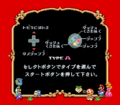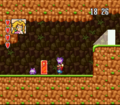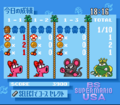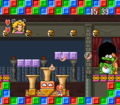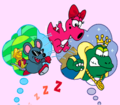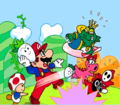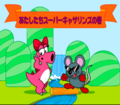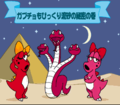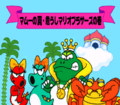BS Super Mario USA
Template:Infobox BS Super Mario USA is a direct sequel to Super Mario Bros. 2 (known as Super Mario USA in Japan) for the Satellaview, an add-on for the Super Famicom. It was the first Mario platformer game to make use of the Satellaview's Soundlink features. The gameplay and levels are essentially the same as the SNES version of Super Mario Bros. 2, but with numerous added features and a new plot, presented as a sequel to the original game.
General information
The game was released in four installments. In each one, the player is sent to a different SMB2 "World". The goal is seemingly to collect the Gold Mario Statues located in each level, defeat the boss, and then find and beat Wart, who can be battled in any world when going down in any vase while the player is in Subspace. The player can select the levels in any order and return to the levels as often as desired until the "episode" ends at around 50 minutes on the clock.
As the gameplay episode progressed, an audio drama would stream via St. Giga's Satellite radio, which would tell the narrative of the story.
Plot outline
After the events of Super Mario Bros. 2, Mario and friends believe Subcon is all a dream and move on. However, Wart returns and overthrows the King of Subcon in the heroes' absence. Mario and his friends must once again face the forces of Wart, including the Birdo trio, Mouser, Tryclyde, Fryguy and Clawgrip.
 This section is a stub. You can help the Super Mario Wiki by expanding it.
This section is a stub. You can help the Super Mario Wiki by expanding it.
Differences/Additions
- The game has a built-in clock (meant to be in sync with real-time) that has the game start at around :05 minutes in and end at around :50 minutes in.
- The player starts the game as Mario. Character changing is forced in timed events.
- Mario Statues are included. Picking up one of these gives Mario an extra life and fills his life meter. There are three of these in each level, plus one obtainable from the end-of-the-world boss. They are usually out in the open, but sometimes are hidden in Subspace. Levels can be played over again in order to obtain all of the statues. It is unknown whether there is a reward for collecting them all.
- The "Today's Results Screen" temporarily records the Mushrooms, Cherries, Coins, Mario Statues, defeated bosses, and current level.
- A points system was added. Points can be gained, among other things, by defeating enemies in various ways.
- Key sequences in the narrative are accompanied by events that occur in-game. The most common of these are the character portraits at the top of the screen which show which character is talking. Other events may include power-ups, power-downs, obstacle-spawnings, or the revealing of secrets.
Gallery
Gameplay screens
Cutscenes
- BS SMUSA Mario & Friends.png
Ōsama (the king of Subcon), his commander, Mario, Luigi, Peach, Toad, and a Golden Mario statue.
Mario and Toad fighting Wart, Birdo, and the 8 bits off with vegetables.
Birdo and Mouser on a grassland.
Birdo, a Red Birdo and Tryclyde on a desert region.
Release info
Being episodic, BS Super Mario USA was released on a weekly basis.
The four episodes were premiered during these weeks: [1]
| Date/Date Range | Japanese | Rōmaji | Translation |
|---|---|---|---|
| 1996/03/31~1996/04/05 | BSスーパーマリオUSA パワーチャレンジ 第1回 「あたしたち、スーパーキャサリンズ」の巻 | BS Super Mario USA Power Challenge Dai-1-kai "Atashitachi, Super-Katherines!" no Maki | BS Super Mario USA Power Challenge Episode 1 Volume of "We, the Super-Birdos!" |
| 1996/04/07~1996/04/12 | BSスーパーマリオUSA パワーチャレンジ 第2回 「ガブチョもびっくり流砂の秘密」の巻 | BS Super Mario USA Power Challenge Dai-2-kai "Gabucho mo Bikkuri Ryuusha no Himitsu" no Maki | BS Super Mario USA Power Challenge Episode 2 Volume of "Tryclyde also surprises, Secrets of the Quicksand" |
| 1996/04/14~1996/04/19 | BSスーパーマリオUSA パワーチャレンジ 第3回 「氷の海でヒーボーボー」の巻 | BS Super Mario USA Power Challenge Dai-3-kai "Kouri no Umi de Hībōbō" no Maki | BS Super Mario USA Power Challenge Episode 3 Volume of "Fry Guy at the Sea of Ice" |
| 1996/04/21~1996/04/26 | BSスーパーマリオUSA パワーチャレンジ 第4回 「マムーの罠,危うしマリオブラザーズ」の巻 | BS Super Mario USA Power Challenge Dai-4-kai "Mamū no Wana, Ayaushi Mario Burazāzu" no Maki | BS Super Mario USA Power Challenge Episode 4 Volume of "Wart's Trap. Watch Out, Super Mario Bros." |
The timeframe in which these episodes were featured was likely 7:00 PM. They were rebroadcast multiple times, but as a full schedule of releases for the Satellaview is not available it is uncertain exactly how many.
Music
The Satellaview's Soundlink-capabilities allowed music to be streamed via Satellite radio. This game used this to enhance its soundtrack with songs that could not be performed via the Super Famicom's soundchips.
As the game played, music from the Super Mario World soundtrack and Super Mario Bros. 1, 2, 3, Hop! Step! Jump! - as well as new, original compositions and jingles - would be used in place of the traditional Super Mario USA music. Surprisingly, none of the music is actually remixed or arranged from the original Super Mario USA.
Staff
- Main article: List of BS Super Mario USA staff
Directed by
- Toshiaki Suzuki
Programmed by
- Shigehiru Kasamatsu
- Yasunori Taketani
- Nobuhito Koganezawa.
Trivia
- The cutscenes depict Mario and Luigi wearing their shirts and overalls in their original color scheme, despite that they have been swapped since 1988.
External links
Footage of game recordings from actual broadcasts. These show how the game plays and the audio drama that accompanies it.
